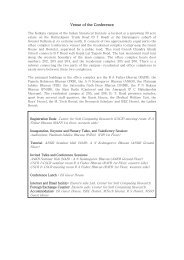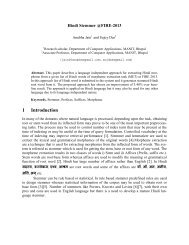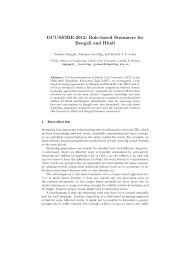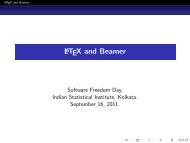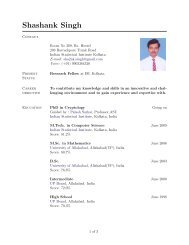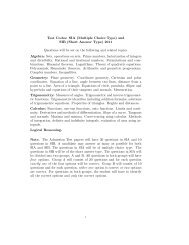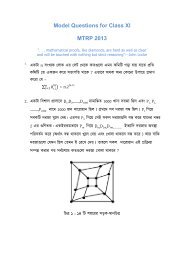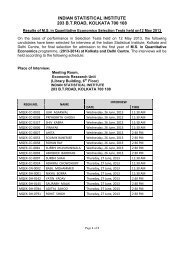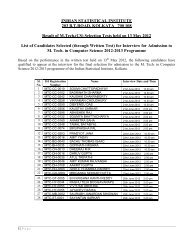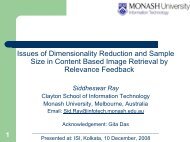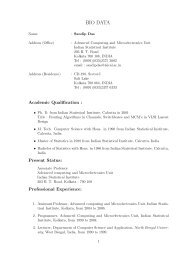A Simulated Annealing Based Multi-objective Optimization Algorithm ...
A Simulated Annealing Based Multi-objective Optimization Algorithm ...
A Simulated Annealing Based Multi-objective Optimization Algorithm ...
Create successful ePaper yourself
Turn your PDF publications into a flip-book with our unique Google optimized e-Paper software.
8displacement measure, a set P ∗ consisting of uniformlyspaced solutions from the true PO front in the <strong>objective</strong> spaceis found (as is done while calculating γ). Then displacementis calculated asdisplacement = 1|P ∗ ||P ∗ | × ∑(min |Q|j=1d(i, j)) (7)i=1where Q is the obtained set of final solutions, and d(i, j) isthe Euclidean distance between the ith solution of P ∗ and jthsolution of Q. Lower the value of this measure, better is theconvergence to and extent of coverage of the true PO front.B. Comparison of Binary Encoded AMOSA with NSGA-II andPAESFirstly, we have compared the binary encoded AMOSAwith the binary-coded NSGA-II and PAES algorithm. ForAMOSA binary mutation is used. Seven test problems havebeen considered for the comparison purpose. These are SCH1and SCH2 [1], Deb1 and Deb4 [31], ZDT1, ZDT2, ZDT6 [1].All the algorithms are executed ten times per problem andthe results reported are the average values obtained for theten runs. In NSGA-II the crossover probability (p c ) is keptequal to 0.9. For PAES the depth value d is set equal to 5.For AMOSA the cooling rate α is kept equal to 0.8. Thenumber of bits assigned to encode each decision variabledepends on the problem. For example in ZDT1, ZDT2 andZDT6 which all are 30-variable problems, 10 bits are used toencode each variable, for SCH1 and SCH2 which are singlevariable problems and for Deb1 and Deb4 which are twovariable problems, 20 bits are used to encode each decisionvariable. In all the approaches, binary mutation applied with aprobability of p m = 1/l, where l is the string length, is usedas the perturbation operation. We have chosen the values ofTmax (maximum value of the temperature), Tmin (minimumvalue of the temperature) and iter (number of iterations ateach temperature) so that total number of fitness evaluations ofthe three algorithms becomes approximately equal. For PAESand NSGA-II, identical parameter settings as suggested in theoriginal studies have been used. Here the population size inNSGA-II, and archive sizes in AMOSA and PAES are setto 100. Maximum iterations for NSGA-II and PAES are 500and 50000 respectively. For AMOSA, T max = 200, T min =10 −7 , iter = 500. The parameter values were determined afterextensive sensitivity studies, which are omitted here to restrictthe size of the article.1) Discussions of the Results: The Convergence and Purityvalues obtained using the three algorithms is shown in TableI. AMOSA performs best for ZDT1, ZDT2, ZDT6 and Deb1in terms of γ. For SCH1 all three are performing equally well.NSGA-II performs well for SCH2 and Dev4. Interestingly, forall the functions, AMOSA is found to provide more number ofoverall nondominated solutions than NSGA-II. (This is evidentfrom the quantities in parentheses in Table I where x y indicatesthat on an average the algorithm produced y solutions ofwhich x remained good even when solutions from other MOOstrategies are combined). AMOSA took 10 seconds to providethe first PO solution compared to 32 seconds for NSGA-II incase of ZDT1. From Table I it is again clear that AMOSA andPAES are always giving more number of distinct solutions thanNSGA-II.Table II shows the Spacing and MinimalSpacing measurements.AMOSA is giving the best performance of Spacingmost of the times while PAES performs the worst. This isalso evident from Figures 6 and 7 which show the final POfronts of SCH2 and Deb4 obtained by the three methods forthe purpose of illustration (due to lack of space final PO frontsgiven by three methods for some test problems are omitted).With respect to MinimalSpacing the performances of AMOSAand NSGA-II are comparable.Table III shows the value of displacement for five problems,two with discontinuous and three with continuous PO fronts.AMOSA performs the best in almost all the cases. The utilityof the new measure is evident in particular for Deb4 wherePAES performs quite poorly (see Figure 7). Interestingly theConvergence value for PAES (Table I) is very good here,though the displacement correctly reflects that the PO fronthas been represented very poorly.Table IV shows the time taken by the algorithms for thedifferent test functions. It is seen that PAES takes less time insix of the seven problems because of its smaller complexity.AMOSA takes less time than NSGA-II in 30 variable problemslike ZDT1, ZDT2, 10 variable problem ZDT6. But for singleand two variable problems SCH1, SCH2, Deb1 and Deb4,AMOSA takes more time than NSGA-II. This may be due tocomplexity of its clustering procedure. Generally for single ortwo variable problems this procedure dominates the crossoverand ranking procedures of NSGA-II. But for 30 variable problemsthe scenario is reversed. This is because of the increasedcomplexity of ranking and crossover (due to increased stringlength) in NSGA-II.C. Comparison of Real-coded AMOSA with the <strong>Algorithm</strong> ofSmith et al. [17] and Real-coded NSGA-IIThe real-coded version of the proposed AMOSA has alsobeen implemented. The mutation is done as suggested in [17].Here a new string is generated from the the old string x byperturbing only one parameter or decision variable of x. Theparameter to be perturbed is chosen at random and perturbedwith a random variable ɛ drawn from a Laplacian distribution,p(ɛ) ∝ e −‖σɛ‖ , where the scaling factor σ sets magnitudeof the perturbation. A fixed scaling factor equals to 0.1 isused for mutation. The initial temperature is selected by theprocedure mentioned in [17]. That is, the initial temperature,T max, is calculated by using a short ‘burn-in’ period duringwhich all solutions are accepted and setting the temperatureequal to the average positive change of energy divided byln(2). Here T min is kept equal to 10 −5 and the temperatureis adjusted according to T k = α k T max, where α is set equalto 0.8. For NSGA-II population size is kept equal to 100and total number of generations is set such that the totalnumber of function evaluations of AMOSA and NSGA-IIare the same. For AMOSA the archive size is set equal to100. (However, in a part of investigations, the archive size



